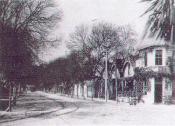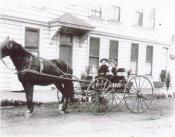Frank Eugene Reanier - The Superintendent of Capitola
by Carolyn Swift - former Director, Capitola Historical Museum
Founded in 1874 by Soquel farmer Samuel Hall, Capitola was established near the wharf at the mouth of the Soquel River. Initially, the camp was an event rather than a place, existing for merely a few weeks in July. Its amenities were a planked stage floor, a livery stable, a stack of tents, and, by the second season, a string of tiny cabins and a crudely built dance hall.
The resort folded up and nearly disappeared in winter. The rest of the time, the beach was known as Soquel Landing and-aside from the vigor of the nearby Italian fishing community tucked at the base of the wharf-the campground was empty. Capitola came back to life only in the late spring, once vacationers announced their desire to return for another summer holiday.
Several years passed before surrounding communities recognized the camp as an enterprise lasting long enough to appear on a map.
In 1882, once Southern Pacific Railroad bought and widened the Santa Cruz-Watsonville rail line, titleholder Frederick Hihn saw that Capitola had been successful enough to become worthy of his investment. He then took direct control of the resort's development and advertised its attractions throughout the state.
Building larger seaside concessions, bathhouses, and a new hotel, Hihn laid out surrounding streets in a circular pattern, naming them for the hometowns of the annual vacationers-places like San Jose, Gilroy, Stockton, and Sacramento. He said the design reminded him of the spas he remembered as a child in Germany, and evidently this was true, because Hihn kept a soft spot in his heart for the village. For years, his birthday celebrations in Capitola were annual events attended by well-wishers from throughout the state.
The direct overseer of Capitola and many other Hihn financial enterprises was Frank Eugene Reanier, a rancher from Nevada County. He and wife Ida and newborn son Elster took up residence in Capitola in 1890, when the thirty-four-year-old Reanier was appointed superintendent.
Although other managers had previously leased the camp, Reanier was hired to run the establishment from the new "superintendent's building," which is now a historical landmark at the corner of Capitola and Monterey Avenues. In this office, Reanier sold cabin lots, accepted rent payments, heard grievances, ordered merchandise, and dispatched workers.
"Frank Reanier is a model superintendent," reported the Santa Cruz Daily Surf in August 1890, "Sometimes he can be seen surrounded by sixteen anxious women all wanting something 'right away quick.' One will have a tea kettle with a hole in it to be mended, another wants straw, another wood, two more must have their trunks taken to the train, another has a frying pan missing the handle, another with a pitiful story about how she couldn't sleep a wink last night, sir, with that baby crying next door. Our Frank listens to all and attends to all without a moment showing a sign of impatience."
By 1902, in addition to Camp Capitola, Reanier took charge of F.A. Hihn Company interests in the Santa Cruz Waterworks, Laurel Timber Mill, Zayante Ranch near Felton, real estate sales in Santa Cruz, Soquel, Aptos, Valencia, and the San Lorenzo Valley, as well as a lumber planing mill at Salinas in Monterey County.
Working for Hihn was no picnic, even in a summer camp.
The Hihn-Younger Archive at UC Santa Cruz, transcribed and indexed by Stan Stevens, contains hundreds of directives. Most were brief orders to perform such chores as delivering ground squirrel poison or vegetables to one of the Hihn Company lumber camps. Others contained a rebuke when instructions were not followed to the letter, particularly regarding the cutting of wood on Hihn property, the payment of water bills, and the collection of rents.
Reanier family records show that Capitola's superintendent sometimes made personal loans to those unable to pay as quickly as Hihn demanded. As exacting as he was, Reanier had nonetheless admired his employer and was a pallbearer at Hihn's funeral in 1913.
Reanier worked two more years for the Hihn family at Capitola, and took charge of the Santa Cruz County exhibit at the Panama-Pacific International Exposition in San Francisco in 1915. The following year, he was appointed Santa Cruz County supervisor from the Soquel District, completing the term of J.D. Esty.
A decade later, in October 1927, Reanier gained distinction as the only Santa Cruz County supervisor appointed to office a second time. Because of his past performance, he was named to finish the term of Supervisor A.W. Wyman of Soquel.
Even though he expressed pleasure about his selection, Reanier told news reporters, "I feel that I have been drafted."
He remained active and assisted community affairs to the benefit of the Soquel District until his death at his Capitola home in February 1931. To this day, when old-timers speak of "the superintendent of Capitola," they mean Frank Reanier.

Superintendent's Building on Capitola Avenue

Reanier family in Capitola ca 1897

Reanier family in Capitola

Reanier family in Capitola


